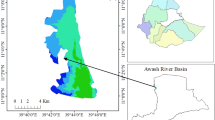Abstract
Water resources is a primary controlling factor for economical development and ecological environmental protection in the inland river basins of arid western China. Groundwater, as the important component of total water resources, plays a dominant role in the development of western China. In recent years, with the utilization ratio of surface water raised, the groundwater recharge rate has been reduced by surface water, and groundwater was exploited on a large-scale. This has led to the decline of groundwater levels and the degradation of eco-environments in the lower reaches of Heihe watershed, especially. Therefore, the study on the groundwater-level change in recent years, as well as simulating and predicting groundwater levels changes in the future is very significant to improve the ecological environment of the Heihe River Basin, coordinate the water contradiction, and allocate the water resources. The purpose of this study is to analyze the groundwater-level variations of the Ejina region basin on a large-scale, to develop and evaluate a conceptual groundwater model in Ejina Basin; according to the experimental observation data, to establish the groundwater flow model combining MODFLOW and GIS Software; simulated the regional hydrologic regime in recent 10 years and compared with various delivery scenarios from midstream; determined which one would be the best plan for maintaining and recovering the groundwater levels and increasing the area of Ejina Oasis. Finally, this paper discusses the possible vegetation changes of Ejina Basin in the future.










Similar content being viewed by others
References
Anderson MP, Woessner WW (1992) Applied groundwater modeling: simulation of flow and advective transport. Academic Press Inc, San Diego, CA
Brodie RS (1998) Integrating GIS and RDBMS technologies during construction of a regional groundwater model. Environ Modell Softw 14:119–128. doi:10.1016/S1364-8152(98)00063-2
Coppola EA Jr et al (2005) A neural network model for predicting aquifer water level elevations. Ground Water 43:231–241. doi:10.1111/j.1745-6584.2005.0003.x
De Hamer W, Love D, Owen R, Booij MJ, Hoekstra AY (2008) Potential water supply of a small reservoir and alluvial aquifer system in southern Zimbabwe. Phys Chem Earth Parts A/B/C 33:633–639. doi:10.1016/j.pce.2008.06.056
Deng JM, Wang GX (2005) Ecological measures of sustainable development of agriculture in the arid areas of China. Sci Tech Rev 23:51–55
Facchi A, Ortuani B, Maggi D, Gandolfi C (2004) Coupled SVAT-groundwater model for water resources simulation in irrigated alluvial plains. Environ Modell Softw 19:1053–1063. doi:10.1016/j.envsoft.2003.11.008
Gedeon M et al (2007) Regional groundwater model of north-east Belgium. J Hydrol 335:133–139. doi:10.1016/j.jhydrol.2006.11.006
Jin XM, Hu GC, Li WM (2008) Hysteresis effect of runoff of the Heihe River on vegetation cover in the Ejina oasis in Northwestern China. Earth Sci Front 15: 198–203 (in Chinese) doi:10.1016/S1872-5791(08)60054-8
McDonald MG, Harbaugh AW (1988) A modular three-dimensional finite-difference ground-water flow model. U.S. Geological Survey Techniques of Water-Resources Investigations, Book 6 Chap A1, p 586
Perkins SP, Sophocleous M (1999) Development of a comprehensive watershed model applied to study stream yield under drought conditions. Ground Water 37:418–426. doi:10.1111/j.1745-6584.1999.tb01121.x
Qin JH, Lv B, Zhao YC (2004) Solonchak resources and soil building effect of salt-tolerant forage grasses. Soils 36:71–75 (in Chinese)
Rodriguez LB, Cello PA, Vionnet CA, Goodrich D (2008) Fully conservative coupling of HEC-RAS with MODFLOW to simulate stream-aquifer interactions in a drainage basin. J Hydrol 353:129–142
Sophocleous M, Perkins SP (2000) Methodology and application of combined watershed and ground-water models in Kansas. J Hydrol 236:185–201. doi:10.1016/S0022-1694(00)00293-6
Su YH, Feng Q, Zhu GF (2007) Identification and evolution of groundwater chemistry in the Ejin Sub-basin of the Heihe River, Northwest China. Pedosphere 17:331–342. doi:10.1016/S1002-0160(07)60040-X
Wu XM (2000) Groundwater exploitation and ecological environment protection in Ejina basin of Heihe River watershed, northwestern China. Wuhan, China Univ Geosci 21:121–125 (in Chinese)
York JP, Filby S (2000) A Holocene hydrologic model of the Crow Wing Watershed, Minnesota. J Geochem Explor 69–70:419–422. doi:10.1016/S0375-6742(00)00135-7
Acknowledgments
Financial support for this study was given from National Natural Science Funds for Distinguished Young Scholar (1140725001)/National Natural Science Foundation of China (40671010). Cosponsored Fellowship is gratefully acknowledged. The authors also appreciate the anonymous referees for their comments towards improvement of this manuscript.
Author information
Authors and Affiliations
Corresponding author
Rights and permissions
About this article
Cite this article
Xi, H., Feng, Q., Liu, W. et al. The research of groundwater flow model in Ejina Basin, Northwestern China. Environ Earth Sci 60, 953–963 (2010). https://doi.org/10.1007/s12665-009-0231-1
Received:
Accepted:
Published:
Issue Date:
DOI: https://doi.org/10.1007/s12665-009-0231-1




